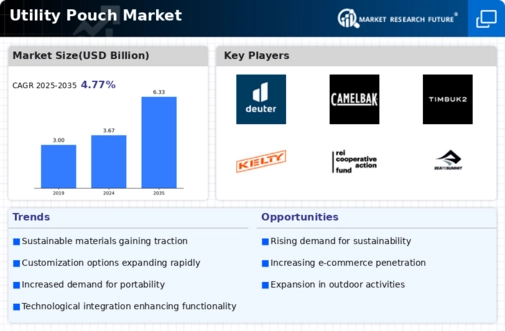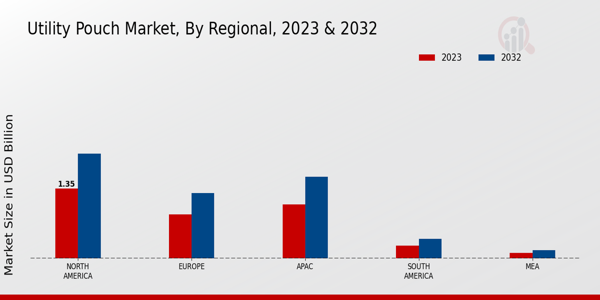Market Growth Projections
The Global Utility Pouch Market Industry is projected to experience substantial growth, with estimates indicating a market size of 3.67 USD Billion in 2024 and a potential increase to 6.33 USD Billion by 2035. This growth trajectory suggests a compound annual growth rate of 5.07% from 2025 to 2035, highlighting the industry's resilience and adaptability to changing consumer preferences. The increasing demand for multifunctional storage solutions, coupled with advancements in materials and design, positions utility pouches as essential items in various sectors, including travel, outdoor activities, and everyday use.
Emergence of E-commerce Platforms
The Global Utility Pouch Market Industry is experiencing a paradigm shift with the emergence of e-commerce platforms. Online retailing provides consumers with easy access to a diverse range of utility pouches, enhancing market visibility and sales potential. The convenience of online shopping aligns with contemporary consumer preferences, particularly among younger demographics. This trend is likely to accelerate market growth, as e-commerce facilitates the introduction of innovative products and brands. As the industry adapts to digital retail strategies, it is poised for expansion, reflecting the changing landscape of consumer purchasing behavior.
Growth in Outdoor and Travel Activities
The Global Utility Pouch Market Industry benefits significantly from the increasing participation in outdoor and travel activities. As individuals engage more in hiking, camping, and travel, the need for practical storage solutions becomes paramount. Utility pouches provide an efficient means to organize essential items, enhancing convenience for outdoor enthusiasts. This trend is reflected in the market's projected growth, reaching 6.33 USD Billion by 2035. The rise in adventure tourism and outdoor recreational activities suggests a sustained demand for utility pouches, as consumers prioritize functionality and portability in their travel gear.
Technological Advancements in Materials
The Global Utility Pouch Market Industry is witnessing a transformation driven by technological advancements in materials. Innovations such as lightweight, durable, and water-resistant fabrics enhance the functionality of utility pouches, making them more appealing to consumers. Manufacturers are increasingly adopting eco-friendly materials, aligning with the growing consumer preference for sustainable products. This shift not only caters to environmental concerns but also positions brands favorably in a competitive market. As a result, the industry is likely to see a compound annual growth rate of 5.07% from 2025 to 2035, reflecting the positive impact of these advancements on market dynamics.
Increasing Urbanization and Lifestyle Changes
The Global Utility Pouch Market Industry is significantly influenced by increasing urbanization and evolving lifestyle changes. As urban populations grow, the demand for compact and efficient storage solutions rises. Utility pouches cater to the needs of urban dwellers who often seek to maximize limited living spaces. This trend is evident in the rising popularity of multifunctional products that combine style and practicality. The market's growth trajectory suggests that utility pouches will continue to thrive as consumers prioritize convenience and organization in their fast-paced lives. This shift underscores the adaptability of utility pouches to modern urban lifestyles.
Rising Demand for Versatile Storage Solutions
The Global Utility Pouch Market Industry experiences a notable surge in demand for versatile storage solutions. As consumers increasingly seek organizational products that cater to various needs, utility pouches have emerged as a preferred choice. These pouches serve multiple purposes, from travel accessories to everyday carry items, appealing to a broad demographic. The market is projected to reach 3.67 USD Billion in 2024, indicating a robust growth trajectory. This trend is further fueled by the growing emphasis on minimalism and efficient space utilization, prompting manufacturers to innovate and diversify their product offerings.
























